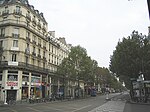Saint-Sépulcre, Paris
14th-century Roman Catholic church buildings in France19th-century disestablishments in FranceBuildings and structures demolished in the 19th centuryDemolished buildings and structures in ParisDestroyed churches in France ... and 3 more
Former Roman Catholic church buildingsFormer buildings and structures in ParisRoman Catholic churches in the 4th arrondissement of Paris

The Chapter of the Holy Sepulchre (French: chapitre du Saint-Sépulcre), also named the Church of the Holy Sepulchre (église du Saint-Sépulcre), was a church in Paris, France.
Excerpt from the Wikipedia article Saint-Sépulcre, Paris (License: CC BY-SA 3.0, Authors, Images).Saint-Sépulcre, Paris
Rue Saint-Denis, Paris 2nd Arrondissement (Paris)
Geographical coordinates (GPS) Address Nearby Places Show on map
Geographical coordinates (GPS)
| Latitude | Longitude |
|---|---|
| N 48.864461 ° | E 2.350194 ° |
Address
La boule maïtre kebabier
Rue Saint-Denis 118
75002 Paris, 2nd Arrondissement (Paris)
Ile-de-France, France
Open on Google Maps








